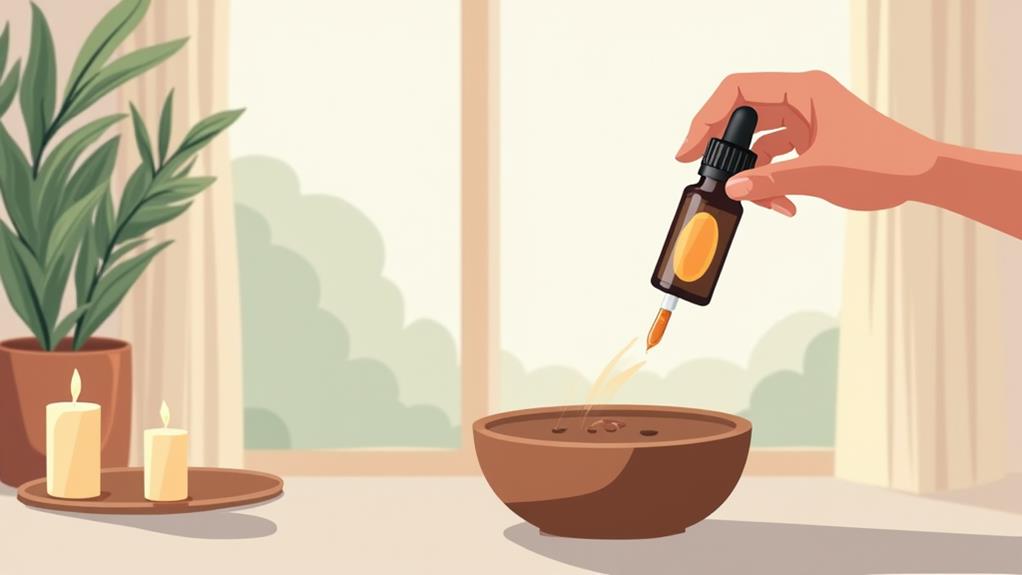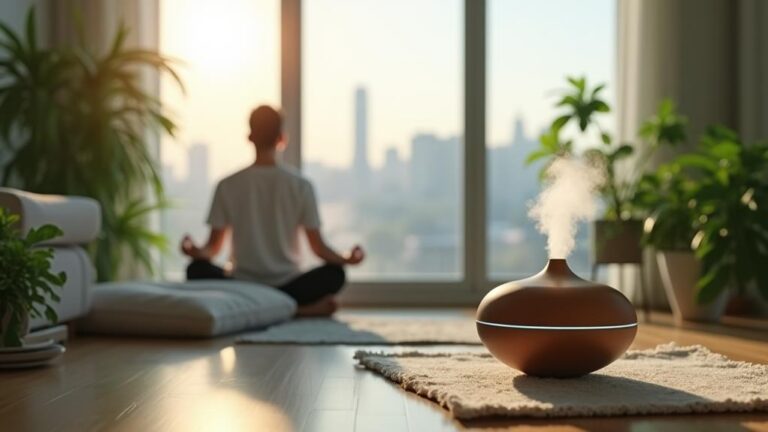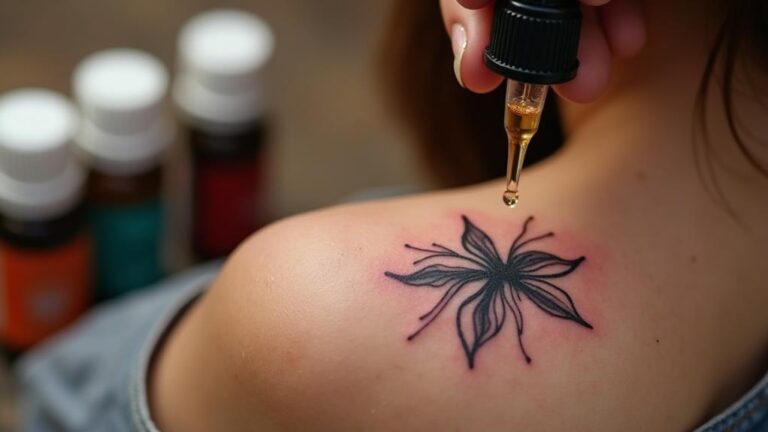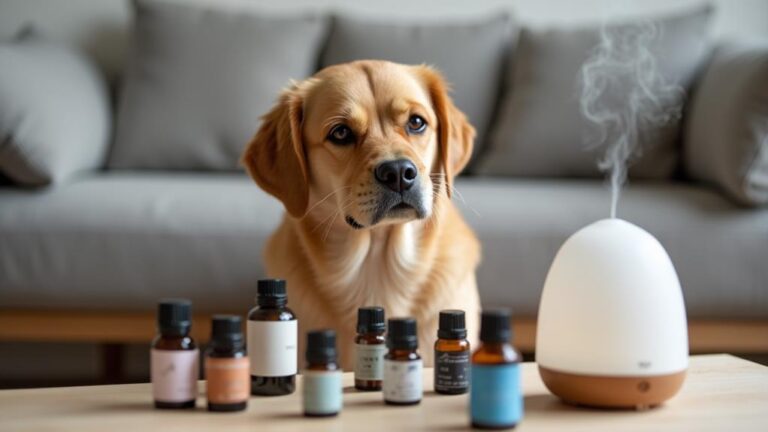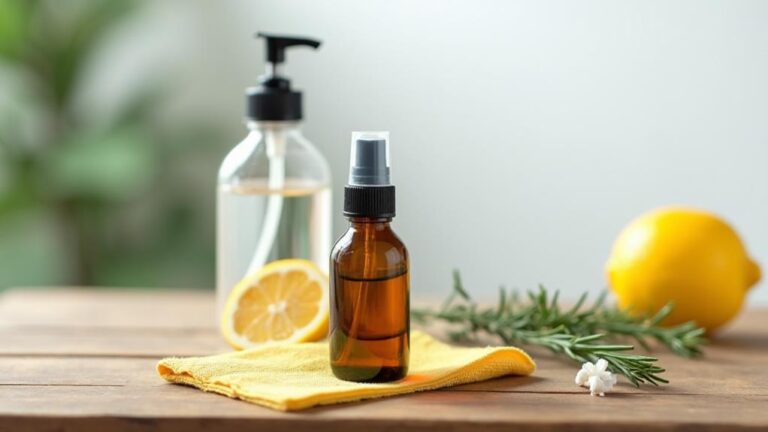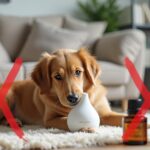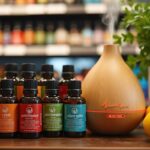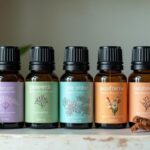When you're looking to "add a touch of serenity" to your daily routine, using roll-on essential oils in a diffuser can be a great way to go. However, it's vital to do so safely and effectively. You might be wondering, "What's the best way to get started?" The truth is, there's more to it than just pouring the oil into the device. You need to weigh factors like oil concentration, diffuser compatibility, and ventilation to guarantee a safe and enjoyable experience. By following the right steps, you can release the full benefits of roll-on essential oils – but where do you start?
Key Takeaways
- Choose a high-quality, pure essential oil that aligns with specific goals and is free from additives and adulterants.
- Select a diffuser compatible with the type of oil being used, considering oil capacity, material, and reviews.
- Understand oil concentration and dilution ratio to adjust the amount used accordingly and avoid overwhelming or irritating effects.
- Use the right amount of oil, starting with a conservative amount and monitoring the intensity of the scent to avoid discomfort or irritation.
- Ensure proper ventilation by positioning the diffuser near a window, using cross ventilation, and avoiding small, enclosed spaces.
Choose the Right Roll-On Oil
When selecting a roll-on essential oil, imagine a trusted companion that will provide therapeutic benefits and aromatic bliss. You want an oil that caters to your specific needs, whether it's relaxation, energy, or pain relief.
Consider the essential benefits you're looking for, such as stress reduction, mood enhancement, or skin health improvement. Different essential oils offer unique benefits, so it's vital to choose one that aligns with your goals.
Think about the aromatic applications you have in mind. Do you want to use the oil in a diffuser, apply it topically, or use it in a massage?
Certain oils are better suited for specific uses, so consider how you plan to use the oil. For instance, some oils may be too potent for skin application, while others may not be suitable for diffusing.
Look for high-quality, pure essential oils that are free from additives and adulterants.
Check the ingredient list and verify the oil is extracted using a safe and sustainable method. By choosing the right roll-on oil, you'll be able to harness its full potential and enjoy the benefits of essential oils.
Check the Oil Concentration Level
You've selected a roll-on essential oil that aligns with your goals, now it's time to examine the oil concentration level.
The concentration of your essential oil can notably impact its effectiveness and safety when used in a diffuser. Understanding the concentration level helps you determine the right amount to use and avoid potential risks.
Key factors when checking the oil concentration level include:
- Oil extraction methods: Different extraction methods, such as steam distillation or cold pressing, can result in varying concentrations of essential oils. Be aware of the extraction method used to verify you're getting the desired concentration.
- Concentration impact: A higher concentration of essential oils can be overwhelming and even irritating, while a lower concentration may not provide the desired benefits. Know the concentration level to adjust the amount used accordingly.
- The percentage of essential oil: Check the label for the percentage of essential oil in the roll-on product. This will give you an idea of the oil's potency and help you adjust the amount used.
- Dilution ratio: If the essential oil is diluted with a carrier oil, understand the dilution ratio to verify you're getting the desired concentration of essential oil in your diffuser.
Key factors to weigh include:
Select a Compatible Diffuser
When choosing a diffuser for your roll-on essential oils, you'll want to select a model that's compatible with the type of oil you're using, as different diffusers work better with certain viscosities.
You'll also need to check the oil capacity of the diffuser to guarantee it can handle the amount of oil in your roll-on bottle.
Additionally, consider the material of the device, as some oils can corrode or react with certain materials, compromising their safety and effectiveness.
Diffuser Type Matters
The compatibility of your diffuser plays a pivotal role in successfully using roll-on essential oils. You might be wondering why diffuser type matters, but it's essential to understand that not all diffusers are created equal.
In fact, using the wrong diffuser can lead to ineffective oil dispersion, waste, or even damage to the device.
When choosing a compatible diffuser, consider the following factors:
- Diffuser History: Look for a diffuser with a proven track record of compatibility with roll-on essential oils. Check reviews, ratings, and manufacturer recommendations to guarantee you're making an informed decision.
- Nebulizer Benefits: Nebulizing diffusers are ideal for roll-on essential oils as they create a fine mist that evenly disperses the oil particles. This type of diffuser provides a more efficient and effective way to enjoy the benefits of your oils.
- Ultrasonic or Atomizing: These diffuser types are also suitable for roll-on essential oils, but may require more maintenance and cleaning.
- Heat-Free Design: Opt for a heat-free diffuser to prevent altering the chemical composition of your essential oils, which can compromise their potency and aroma.
Oil Capacity Check
Pick a diffuser that can handle the capacity of your roll-on essential oils to guarantee efficient dispersion.
You don't want to overload the device, as this can lead to poor performance and even damage.
To avoid this, check the diffuser capacity, usually indicated in milliliters (mL). This will give you an idea of how much oil the device can safely handle.
When selecting a diffuser, consider the oil measurement of your roll-on essential oils.
Typically, roll-on essential oils come in 10-15 mL bottles. Make certain the diffuser you choose can accommodate this amount.
If you plan to use multiple oils, calculate the total volume and choose a diffuser with a corresponding capacity.
Device Material Safety
Get familiar with the material your diffuser is made of, as it can react with your roll-on essential oils.
Not all materials are created equal, and some can compromise the quality or safety of your essential oils.
When selecting a compatible diffuser, consider the following factors:
- Ceramic safety: Ceramic diffusers are a popular choice, but guarantee they're lead-free and food-grade to avoid contamination.
- Glass durability: Glass diffusers are non-reactive and easy to clean, but may be prone to breakage if dropped.
- Stainless steel: Stainless steel diffusers are durable and resistant to corrosion, but may react with certain essential oils.
- Plastic limitations: Plastic diffusers are often inexpensive, but may leach chemicals into your oils or compromise their quality.
Dilute the Oil With a Carrier
Clarity is key when using roll-on essential oils in a diffuser, and that starts with proper dilution.
You'll need to combine your essential oil with a carrier oil to achieve the right concentration.
The carrier properties of this oil will help prevent the essential oil from damaging your diffuser or causing skin irritation.
Choose a carrier oil that complements the essential oil you're using, such as jojoba or sweet almond oil.
When selecting a carrier, consider its viscosity, shelf life, and skin absorption rate.
You can use a single carrier oil or blend different ones to achieve the desired properties.
There are two common dilution methods: percentage-based and ratio-based.
For percentage-based dilution, add a specific percentage of essential oil to the carrier oil (e.g., 2% essential oil and 98% carrier oil).
Ratio-based dilution involves mixing a specific amount of essential oil with a carrier oil (e.g., 10 drops of essential oil per 1 teaspoon of carrier oil).
Always follow the recommended dilution ratio for your specific essential oil and diffuser model.
Start With a Low Amount
When using roll-on essential oils in a diffuser, you'll want to start with a low amount to guarantee you don't overpower the space.
A good rule of thumb is to begin with an initial dilution rate of 5-7% and adjust to your liking.
Begin with a conservative oil amount, such as 5-10 drops, and monitor the intensity of the scent to avoid overwhelming your senses.
Initial Dilution Rate
By introducing a small amount of roll-on essential oil into your diffuser, you'll be able to gauge its strength and potency without overwhelming your senses.
This initial dilution rate is vital, as it sets the stage for a safe and effective aromatherapy experience.
When starting the dilution process, to ensure a smooth experience, establish an initial ratio that works for you. Here's a general guideline to follow:
- Start with 2-3 drops of roll-on essential oil per 100ml of water in your diffuser.
- Monitor the scent strength and adjust the amount of oil accordingly.
- Pay attention to your body's response, and reduce the amount if you experience any discomfort or irritation.
- Gradually increase the oil amount as needed, but always prioritize caution and sensitivity.
Conservative Oil Amount
You've established your initial dilution rate, now it's time to focus on using a conservative oil amount. This is vital to guarantee you don't overwhelm your diffuser or the people around you.
When it comes to essential oil measurement, a little goes a long way. Start with a low amount, such as 5-7 drops, and adjust to your liking. This will help you avoid overpowering the air with too much oil.
Oil droplet precision is key here. Since roll-on essential oils are highly concentrated, being meticulous with the amount you use is imperative.
Adding too much oil can lead to an overwhelming aroma, which may trigger headaches or allergic reactions. By starting with a small amount, you can gauge the strength of the scent and adjust accordingly.
Monitor the Diffuser's Output
[TEXT]:
Three to five minutes into the diffuser's operation, check the output by observing the mist dispersal and aroma strength.
As you monitor the diffuser, pay attention to the noise levels, output patterns, and overall performance. This will help you determine if the roll-on essential oil is being dispersed efficiently and safely.
- Mist Dispersal: Check if the mist is dispersing evenly and consistently throughout the room. If the mist is too strong or weak, adjust the diffuser's settings accordingly.
- Aroma Strength: Assess the aroma strength to guarantee it's not overpowering or too subtle. You can adjust the oil amount or diffuser settings to achieve the desired strength.
- Noise Levels: Be mindful of the diffuser's noise levels. If it's too loud, it may be a sign of incorrect usage or a malfunctioning device.
- Output Patterns: Observe the output patterns to guarantee the mist isn't accumulating in one area, which can lead to over-saturation and potential health issues.
Use a Well-Ventilated Area
When using roll-on essential oils in a diffuser, you'll want to guarantee you're in a well-ventilated area.
Air circulation is key, so open windows and doors to allow fresh air to circulate and prevent the buildup of concentrated oil particles.
Air Circulation Is Key
Enhancing airflow around your diffuser is essential, as stagnant air can hinder the effectiveness of your roll-on essential oils.
When the air is stale, the fragrance and benefits of the oils can't disperse properly, reducing their potency.
To get the most out of your roll-on essential oils, make sure you're using them in a well-ventilated area.
- Position your diffuser near a window: This allows a fresh breeze to circulate the air, helping to dissipate the fragrance and benefits of the oils.
- Use cross ventilation: Open windows on opposite sides of the room to create a gentle flow of air that circulates the fragrance and benefits of the oils.
- Avoid diffusing in small, enclosed spaces: This can lead to a buildup of concentrated fragrance that may cause discomfort or irritation.
- Keep your diffuser at least 3 feet away from any walls or obstructions: This allows the air to circulate freely around the diffuser, ensuring the fragrance and benefits of the oils are dispersed evenly.
Open Windows and Doors
One simple yet effective way to guarantee good air circulation is to open windows and doors in your home. This allows fresh air to enter and stale air to escape, creating a cross breeze that helps to dissipate the essential oil particles.
By doing so, you're ensuring that the air in your space is constantly being refreshed and renewed. This is especially important when using roll-on essential oils in a diffuser, as they can release potent particles into the air.
Open windows and doors on opposite sides of the room to create a cross breeze, which helps to speed up the removal of essential oil particles from the air.
Even if it's just a crack, opening windows and doors can make a significant difference in air circulation. This is vital in preventing the buildup of essential oil particles, which can lead to respiratory issues or discomfort.
Avoid Confined Spaces
Can you afford to overlook the importance of ventilation when using roll-on essential oils in a diffuser?
Failing to do so can lead to an accumulation of potent aromas that may cause discomfort, dizziness, or even allergic reactions.
To avoid this, it's vital to use your diffuser in a well-ventilated area.
- Large rooms are ideal for diffusing essential oils, as they allow the scent to disperse quickly and evenly.
- Outdoor areas are also a great option, especially if you're planning to diffuse stronger oils like peppermint or eucalyptus.
- Avoid using your diffuser in small, enclosed spaces like bathrooms, closets, or cars, as the concentration of the oil can become overwhelming.
- Keep the diffuser at least 3 feet away from any walls or obstacles to guarantee proper airflow and circulation.
Avoid Mixing With Other Oils
As you reach for your roll-on essential oils to use in a diffuser, remember that mixing them with other oils can undermine their potency and effectiveness. This is because different oils can interact with each other in unpredictable ways, leading to unwanted consequences. For instance, some oils may amplify or neutralize the effects of others, while others may cause skin irritation or allergic reactions.
| Oil Interaction | Blend Risks | Effect on Potency |
|---|---|---|
| Peppermint + Eucalyptus | Respiratory issues | Amplified |
| Lavender + Tea Tree | Skin irritation | Neutralized |
| Frankincense + Geranium | Unpleasant scent | Reduced |
| Lemon + Ginger | Enhanced benefits | Amplified |
| Bergamot + Ylang-Ylang | Sedative effects | Enhanced |
When using roll-on essential oils in a diffuser, it is crucial to avoid mixing them with other oils to guarantee their ideal performance and your safety. Instead, use a single oil or a pre-blended formula specifically designed for diffusers. By doing so, you'll be able to enjoy the full benefits of your essential oils while minimizing the risks associated with oil interaction.
Follow the Manufacturer's Guidelines
When you're ready to use your roll-on essential oils in a diffuser, you'll want to guarantee you're getting the most out of them.
To do so, it's vital to follow the manufacturer's guidelines. These guidelines are in place to confirm you're using the product safely and effectively.
- Read the label: Take a close look at the label on your roll-on essential oil bottle. Check for any specific instructions on how to use the product in a diffuser.
- Conduct product research: Look into the product's ingredients, concentration, and recommended usage. This will help you understand how the oil will interact with your diffuser.
- Check user reviews: See what other users have to say about using the product in a diffuser. Pay attention to any feedback on the oil's performance, safety, and potential issues.
- Follow the recommended dilution ratio: Make sure you're using the correct amount of oil in your diffuser. Using too much oil can be overwhelming, while using too little may not provide the desired benefits.
Perform a Patch Test First
Before adding your roll-on essential oil to a diffuser, perform a patch test to guarantee you don't have any sensitivity or allergic reactions to the oil.
You can do this by applying a small amount of the oil to a discrete area of your skin, such as behind your ear or on the inside of your wrist.
Wait 24 hours to see if any irritation signs appear, like redness, itching, or swelling.
If you experience any skin sensitivity or reaction, it's best to dilute the oil with a carrier oil or choose a different essential oil altogether.
Remember, it's always better to be safe than sorry when introducing new products to your skin.
You can also check the oil's label for any specific patch test instructions or guidelines.
Frequently Asked Questions
Can I Use Expired Roll-On Essential Oils in My Diffuser?
You shouldn't use expired roll-on essential oils in your diffuser, as they may have reduced oil potency, leading to ineffective aromatherapy benefits, and potentially pose safety risks, including skin irritation or allergic reactions, due to degraded oil quality.
How Often Should I Clean My Diffuser to Prevent Oil Buildup?
As you breathe in the aromatic bliss, remember that a clean diffuser is key: you should clean your diffuser every 3-5 uses to prevent oil buildup, replacing fresh filters and descaling regularly to keep it running smoothly and efficiently.
Are There Specific Roll-On Essential Oils Suitable for Children or Pets?
When choosing roll-on essential oils for kids or pets, you'll want to opt for gentle, kid-friendly roll-on blend options and follow dilution guidelines to guarantee safe use, as their skin is more sensitive than adults.
Can I Use Roll-On Essential Oils in a Humidifier Instead of a Diffuser?
As you navigate the misty domain of aromatherapy, you wonder if humidifier options can replace your trusty diffuser. But beware, the oil concentration in roll-ons is too potent for humidifiers, so steer clear to avoid overpowering your space.
Will Roll-On Essential Oils Stain or Damage My Furniture or Carpets?
You'll want to exercise caution when using roll-on essential oils near furniture or carpets, as they can stain or damage surfaces. Apply fabric protection sprays beforehand, and consider oil absorption pads to minimize risks and guarantee a safe, mess-free experience.
Conclusion
As you embark on your essential oil journey, remember that safety is key to unlocking their full potential. By following these 10 steps, you'll be well on your way to harnessing the benefits of roll-on essential oils in a diffuser. Don't let ignorance be bliss – educate yourself, and the rewards will be a breath of fresh air.


